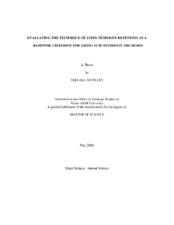| dc.description.abstract | Six Quarter Horse yearling fillies were used in a duplicated 3 x 3 Latin square
designed experiment to evaluate the technique of nitrogen retention as a response
criterion for amino acid studies in the horse. The yearlings were paired by age and
randomly assigned to one of three concentrates fed with a medium quality Coastal
Bermudagrass hay throughout the study. Diets were fed at approximately 1.9% of horse
body weight per day, divided into twice daily feedings with a 60:40 concentrate: hay
ratio. With the exception of lysine and threonine, proposed amino acid requirements for
yearling horses were calculated using nutrient to calorie ratios of gilts weighing 80-120
kg and gaining 325 g/d.
Diet A was amino acid sufficient, as provided by a soybean meal-based concentrate.
Diet B was amino acid deficient, with a cottonseed hull-based concentrate. Diet A and
Diet B were isonitrogenous, containing approximately 12% crude protein. Diet C used
the identical concentrate as Diet B, with synthetic essential amino acids and cysteine
orally dosed to match the amino acid levels in Diet A. Nitrogen retention was not
different between Diet A and Diet B. Diet C resulted in differences from Diets A and B
in nitrogen retention; however, differences were a consequence of nitrogen intake. Nitrogen retained as a percent of nitrogen absorbed was lower (P < 0.05) for Diet B than
for Diet A, for data not accounting for endogenous fecal and urinary losses. There were
no differences in nitrogen retained as a percent of nitrogen absorbed for horses fed Diet
C, when compared to either Diet A or Diet B, for data not accounting for endogenous
losses.
It was concluded that differences in nitrogen retained as a percent of nitrogen
absorbed were observed between amino acid sufficient diets and amino acid deficient
diets. However, horses fed amino acid deficient diets and orally dosed with synthetic
amino acids, likely require some modified dosage level to achieve the same or higher
values in nitrogen retained as a percent of nitrogen absorbed as those values for amino
acid sufficient diets. | en |


